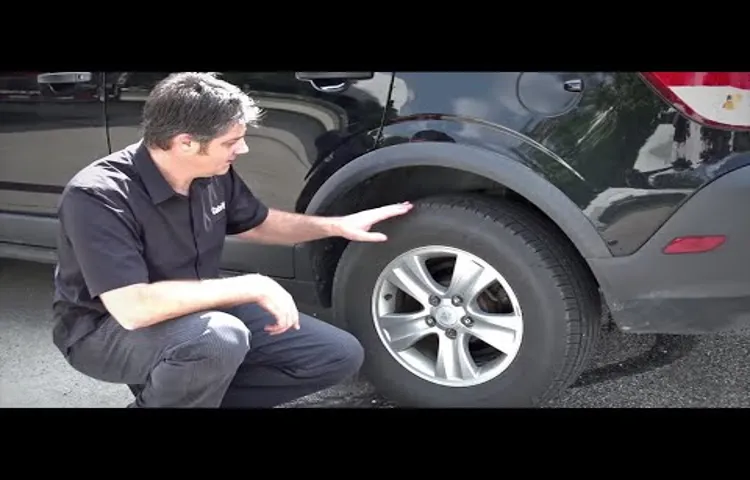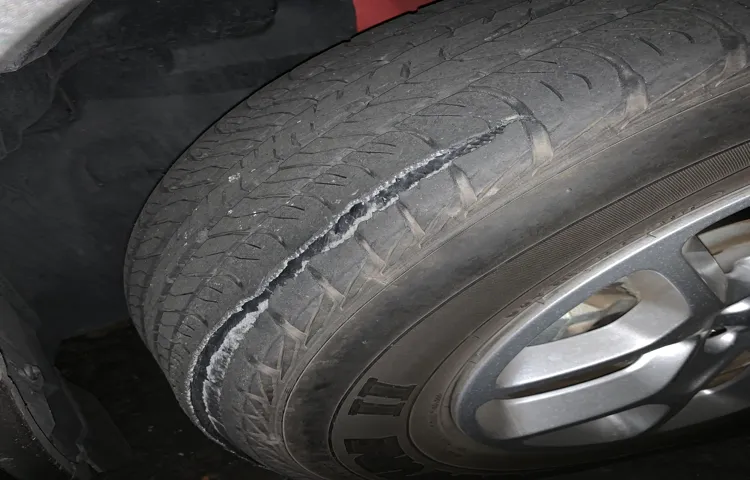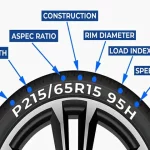Do you ever feel like your vehicle is bouncing more than usual when you’re driving down the road? It might feel like you’re riding on a pogo stick instead of four wheels. This can be a startling experience, especially if you’re not sure what’s causing it. Fortunately, there are several possible explanations for why your tire might be bouncing like this.
In this blog, we’ll take a closer look at some of the common reasons why your tire might be bouncing and what you can do about it. So, put on your seatbelt and let’s dive in!
Table of Contents
Possible Causes
Tire bouncing while driving is an uncomfortable and potentially unsafe issue that many drivers experience. There are several possible causes for tire bouncing, including worn out or unbalanced tires, worn suspension components, bent wheels, or even issues with the drive train. Uneven tire pressure, particularly in the front tires, can also contribute to tire bouncing.
To determine the root cause of tire bouncing, it’s essential to inspect the tires, wheels, and suspension components for damage or wear. Proper alignment, balance and maintenance of the tires can help reduce tire bouncing and provide a safer driving experience. If you notice tire bouncing, don’t ignore it, as it can lead to uneven tire wear, decreased fuel efficiency and impaired handling on the road.
Worn Out Tires
Are your tires looking a little worn out? There are a few possible causes that could be contributing to this issue. One common cause is overinflation or underinflation. When your tires are not properly inflated, it can lead to uneven wear over time.
Another factor to consider is your driving habits. Do you tend to brake hard or take sharp turns frequently? This type of driving can lead to increased wear and tear on your tires. Additionally, the type of terrain you drive on can also play a role.
If you frequently drive on rough or uneven roads, your tires may wear out faster than if you mainly stick to smooth highways. It’s important to keep these factors in mind when troubleshooting the cause of worn out tires. By being mindful of your driving habits and maintaining proper tire inflation, you can help extend the life of your tire and stay safe on the road.

Wheel Misalignment
Wheel misalignment can be caused by a variety of factors. One common cause is hitting a curb or pothole, which can knock your wheels out of alignment. Another potential factor is worn out suspension components, which can cause your wheels to shift out of position.
Over time, even regular wear and tear can cause your wheels to become misaligned. Regardless of the cause, it’s important to address wheel misalignment promptly to prevent further damage to your vehicle. If you notice that your car is pulling to one side while driving, or if your steering wheel is vibrating or shaking, it may be a sign that your wheels are out of alignment.
A professional mechanic can diagnose the issue and recommend the best course of action to get your vehicle back on track. Don’t wait until it’s too late – addressing wheel misalignment early can save you time, money, and hassle down the road.
Low Tire Pressure
Low tire pressure can be a nuisance, causing a rough and bumpy ride. But what are the possible causes of this issue? One common reason is a punctured or damaged tire, which leads to air leakage and low pressure. However, low tire pressure can also be caused by temperature changes.
As the weather cools down, the air in the tire condenses, leading to a decrease in pressure. This is why many people experience low tire pressure during the winter months. Additionally, a faulty valve stem or an issue with the TPMS sensor can cause inaccurate readings and lead to low tire pressure.
It’s important to regularly check your tire pressure and address any issues promptly to ensure a safe and comfortable driving experience.
Suspension Issues
Suspension issues can cause a variety of problems for your vehicle. One possible cause is worn out shocks or struts. These components deteriorate over time and can cause your vehicle to bounce as you drive.
Another possible cause is worn out suspension bushings. These small rubber pieces help to absorb shocks and vibrations, but can wear out over time, leading to a rough ride. Additionally, bent or damaged suspension components such as control arms or tie rods can cause issues with your vehicle’s alignment, leading to uneven tire wear and poor handling.
It’s important to address suspension issues as soon as possible to avoid further damage and ensure your safety on the road. By addressing these issues promptly with a qualified mechanic, you can enjoy a smoother, safer ride.
How to Fix the Problem?
Are you experiencing the unpleasant sensation of your tire bouncing when driving? This issue could be caused by several factors, including low air pressure, worn-out shocks or struts, or even a damaged wheel or tire. The first step in fixing the problem is to check your tire pressure and ensure it’s at the recommended level. If that doesn’t solve the issue, it’s best to take your vehicle to a reputable mechanic who can diagnose the problem accurately and provide the necessary repairs.
Ignoring this problem can lead to safety hazards while on the road, including decreased traction, longer stopping distance, and even tire blowouts. So, it’s essential to act quickly and get your vehicle checked out as soon as possible. Don’t let a bouncing tire ruin your driving experience; take the necessary steps to fix the problem and ensure a smooth ride every time.
Inspect Your Tires
Inspecting your tires regularly is crucial to ensuring your safety on the road. To fix any issues, start by inspecting the tire pressure and making sure it’s at the recommended level. If it’s not, fill it up with air until it reaches the recommended pressure.
Check the tread depth of each tire as well to ensure it meets the minimum requirements. If your tires are worn or damaged, consider getting them replaced as soon as possible. Additionally, look for any visible signs of damage, such as cracks or bulges, which could potentially lead to a blowout.
By keeping your tires in good condition, you can increase your vehicle’s fuel efficiency, extend the life of your tires, and most importantly, stay safe on the road. So, make inspecting your tires a regular habit and stay on top of any issues that arise.
Check Wheel Alignment
If you ever notice that your car is drifting to one side of the road or your steering wheel is off-center even when driving straight, it’s probably a sign that your wheel alignment is off. But don’t worry, fixing the problem is pretty simple. Firstly, take your car to a reputable mechanic shop to diagnose the problem, which will probably involve a test drive to see how the car performs on the road.
If your mechanic finds that the wheel alignment is off, they will use specialized equipment to adjust the angles of your wheels to the manufacturer’s specifications. This process is called wheel alignment, and it will ensure that your car handles, brakes, and steers like it’s supposed to. Remember, getting your wheel alignment checked regularly can prevent premature tire wear and save you money in the long run.
So don’t ignore those warning signs and schedule an appointment today!
Check Tire Pressure
When it comes to maintaining your car’s performance and ensuring a smooth ride, checking your tire pressure is an essential task that should never be overlooked. Low tire pressure not only affects your fuel efficiency and driving experience but can also lead to safety hazards on the road. But don’t worry, fixing this problem is much easier than you might think.
Firstly, check your vehicle’s owner’s manual for the recommended tire pressure. Then, use a tire pressure gauge to check the pressure levels and refill or deflate the tires according to the recommended levels. It’s best to check your tire pressure at least once a month and before long trips.
Always remember, proper tire pressure is crucial in ensuring the safety and longevity of your vehicle and its tires.
Check Suspension
Suspension If your car’s suspension is giving you trouble, it’s important to address the problem before it worsens. There are a few signs to look out for when checking your suspension, such as a bumpy ride, vibrations, or the car pulling to one side. Once you’ve identified the issue, you can begin tackling the problem.
One common solution is to replace the shocks or struts, as these components are responsible for absorbing the impact from uneven roads and bumps. It’s important to choose high-quality replacement parts, as cheap or low-grade options can lead to further issues down the line. Additionally, ensuring proper alignment and tire rotation can alleviate stress on the suspension components.
Regular maintenance and attention to your car’s suspension can lead to a smoother ride and prevent costly repairs in the future. So, if you’re experiencing any issues with your suspension, don’t hesitate to take action and fix the problem for a safer, more enjoyable driving experience.
Preventing Tire Bouncing
Tire bouncing when driving can be really annoying and even dangerous. Not only does it make the ride uncomfortable but it can also affect the overall handling of the vehicle. To prevent tire bouncing, there are a few things you can do.
First and foremost, ensure that your tires are properly inflated. Overinflated or underinflated tires can cause bouncing, so make sure to check your tire pressure regularly. Another thing to consider is the type of tires you have.
Low-quality or worn-out tires can also lead to bouncing, so invest in good quality ones. It’s also important to avoid overloading your vehicle as this can put too much weight on the tires, causing them to bounce. Lastly, always drive at a reasonable speed.
Driving too fast can cause the tires to lose contact with the road, leading to bouncing. By following these simple tips, you can prevent tire bouncing and ensure a smooth, safe driving experience.
Regular Car Maintenance
Regular car maintenance is essential to keep your vehicle running smoothly and ensure it is safe to drive. One of the common issues that drivers may encounter if they neglect their car’s maintenance is tire bouncing. This occurs when the tires are imbalanced, which can cause them to bounce up and down while driving.
This can be dangerous, as it affects your car’s stability and can cause problems with steering and braking. To prevent tire bouncing, it is important to regularly check your tire pressure and make sure they are inflated to the correct level. You should also have your tires balanced and rotated every 6,000 miles or as recommended by your vehicle’s manufacturer.
Regularly inspecting your tires for wear and damage is also important, as damaged or excessively worn tires can lead to bouncing and other problems. By taking these steps, you can prevent tire bouncing and ensure your car is safe and reliable on the road.
Avoid Overloading Your Car
When planning a road trip or simply running errands, it’s important to remember that overloading your car can cause a multitude of problems, including tire bouncing. Tire bouncing, also known as “cupping,” occurs when your tires make contact with the road unevenly. This can lead to a bumpy ride, decreased traction, and ultimately, a shorter tire life.
To prevent tire bouncing, start by checking your vehicle’s maximum load capacity and staying within those limits. Distribute the weight evenly throughout your car, placing heavier items on the bottom and lighter items on top. Additionally, make sure your tires are properly inflated and rotated regularly.
By taking these precautions, you’ll not only improve your ride quality but also ensure the safety of yourself and others on the road.
Avoid Potholes and Rough Roads
Preventing Tire Bouncing: Tips for Avoiding Potholes and Rough Roads When you hit a pothole or rough road while driving, it can lead to your vehicle bouncing up and down uncontrollably – a phenomenon known as tire bouncing. Not only does this make for an uncomfortable ride, but it can also cause damage to your vehicle and increase the risk of an accident. Fortunately, there are a few things you can do to prevent tire bouncing when navigating through rough roads.
First and foremost, it’s important to be aware of your surroundings and watch out for potholes in the road. This means keeping your eyes on the road ahead and avoiding any distractions that may take your attention away from driving. In addition, you can try to anticipate bumps and dips in the road by slowing down before you reach them.
Another effective way to prevent tire bouncing is to ensure that your vehicle’s shocks and struts are in good working order. These components help to absorb the impact of bumps and potholes, allowing your vehicle to maintain a smooth and stable ride. If you notice any signs of wear and tear on your shocks or struts, it’s important to have them inspected and replaced as soon as possible.
Finally, you can consider investing in high-quality tires that are specifically designed for rough roads and uneven terrain. These tires are designed with deeper treads and thicker sidewalls, providing greater protection against potholes and other hazards. By taking these steps, you can help prevent tire bouncing and ensure a safe and comfortable ride, no matter where your travels take you.
Conclusion
In conclusion, tire bouncing when driving is like trying to dance the tango with two left feet – it’s embarrassing, inefficient, and potentially dangerous. So, let’s make sure our tires are inflated to the proper pressure, aligned correctly, and balanced evenly. Only then can we confidently hit the road and avoid being the laughing stock of the dance floor – I mean, highway.
“
FAQs
Why is my tire bouncing when I drive?
Your tire bouncing could be caused by several factors, including low tire pressure, damaged tires, or misaligned wheels.
How do I know if my tire is damaged and causing bouncing while driving?
Inspect your tire for visible signs of damage, such as cuts or bulges on the sidewall or tread. Additionally, check for bald spots on the tire tread, which could cause bouncing.
Can misaligned wheels cause tire bouncing while driving?
Yes, uneven wear on your tire due to misaligned wheels can cause bouncing while driving. Have a professional mechanic inspect and align your wheels to correct this issue.
Is it safe to drive with a tire that is bouncing?
No, driving with a bouncing tire is dangerous as it can cause loss of control or a blowout. Have your tire inspected and repaired immediately.
How can tire pressure affect bouncing while driving?
Low tire pressure can cause bouncing as the tire is not properly inflated and cannot absorb the shock of the road. Check and maintain proper tire pressure to prevent this issue.
What should I do if my tire is still bouncing after checking pressure, alignment, and damage?
If your tire is still bouncing, it may be time to replace it. Consult with a tire professional to determine the best options for your vehicle.
Can a pothole or road hazard cause tire bouncing while driving?
Yes, hitting a pothole or road hazard can cause tire damage or misalignment, leading to bouncing while driving. Avoid hazards when possible and have your tire inspected if such an incident occurs.



